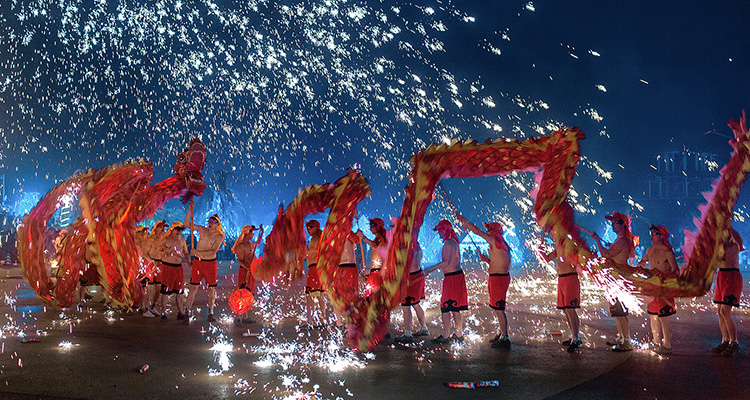Experience Beijing Dragon Dance: Traditional Lunar New Year Celebration in China
In Beijing, especially during Lunar New Year celebrations, you may witness a massive “dragon” weaving through streets and alleys—its scales glimmering, eyes shining like gold, leaping and twisting to the thunderous beat of drums. This is the vibrant and joyful Beijing Dragon Dance. It is not just a performance but a moving festival, symbolizing good luck, courage, and collective energy, bringing the festive spirit to life.
1. What Is It? A Collaborative Moving Art
At first sight, the Dragon Dance is awe-inspiring. A long dragon, often controlled by over ten performers, follows the lead dancer to spin, roll, and leap, appearing as a living dragon soaring through the air.
You can think of it as “a Chinese-style group movement dance.” Unlike the Lion Dance, it emphasizes teamwork and fluid coordination. The undulating dragon body, sparkling golden scales, and grand music together create a visually stunning spectacle, radiating energy and excitement.

2. Its Legendary Story: From Rain Prayers to Public Celebration
The Dragon Dance has a long history, tracing back to ancient agricultural societies. Originally, it was a ritual to pray for favorable weather and abundant harvests. In Chinese culture, the dragon controls wind and rain, so people danced dragon shapes to honor heaven and ensure a prosperous year.
In Beijing, the Dragon Dance is deeply rooted in local folk traditions. It is essential for festivals such as Lunar New Year and Lantern Festival, symbolizing luck, wisdom, and strength. Watching the dragon means witnessing prosperity and joy—a festive blessing for everyone.

3. How to Bring the Dragon to Life? Perfect Harmony of People and Rhythm
Animating a giant dragon is an art of strength, skill, and teamwork.
- Materials and Roles: The dragon body is usually made of bamboo, wire, and fabric—light yet sturdy. The dragon team includes the “Dragon Pearl” (leader) and performers controlling the body with wooden poles. Each performer must move in precise coordination and rhythm to simulate the dragon soaring through the sky.
- Artistic Elements: The performance is accompanied by drums, gongs, and cymbals, which dictate the dragon’s movements. Common sequences include “Dragon Emerging from the Sea,” “Passing Through the Dragon Gate,” and “Coiling Dragon,” each telling a different story and showing the dragon as majestic or playful.

4. How to Fully Appreciate It? Follow the Dragon’s Path
Enjoying the Dragon Dance requires only your presence and attention to its rhythm and energy.
- Viewing Tips:
- Observe the Whole: Watch the dragon’s fluid movements and wave-like curves.
- Notice Coordination: Pay attention to performers’ synchronized steps—the core of the dragon’s charm.
- Listen to the Drumbeats: Feel the energy as the music and movements perfectly align.
- Interactive Experience: When the dragon passes by, gently touch its body to “absorb dragon energy,” believed to bring good luck for the year. Applaud and cheer—your enthusiasm fuels the performers’ energy.

5. Where to Experience It? Join the Festive Celebration
To witness or even join the celebration, head to Beijing’s major festive events.
- Best Places to Watch:
- Spring Festival Temple Fairs: Ditan Temple Fair, Longtan Lake Temple Fair, where daily performances are scheduled.
- Lantern Festivals: Qianmen Street, Summer Palace—Dragon Dance often combines with spectacular lantern displays.
- Major Celebrations: Cultural festivals or National Day events often feature Dragon Dance teams.
- Learning Opportunities: If you’re inspired, check out traditional culture clubs in Beijing universities or community cultural centers, which sometimes offer hands-on experiences to try holding a dragon pole and feel its weight and rhythm.
When traveling in Beijing, if you hear the familiar beat of drums in the distance, follow the sound. That golden dragon weaving through the crowd awaits to bring you the most lively and authentic Chinese blessing—a memory that will shine brightly in your travel experiences.


